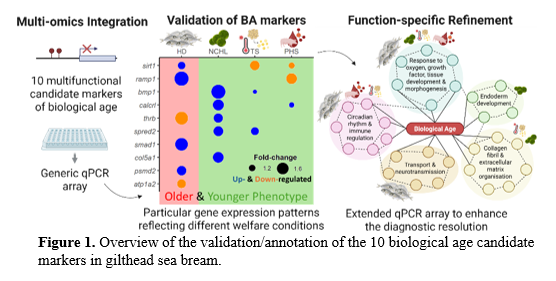DECODING BIOLOGICAL AGEING TO ENHANCE WELFARE IN FARMED SEA BREAM: A TRANSCRIPTIONAL AND EPIGENETIC APPROACH
Introduction
As aquaculture expands to meet global food demands, the need for innovative tools to monitor fish welfare and wellbeing is growing. Biological age (BA), unlike chronological age, offers a more accurate measure of overall welfare by reflecting the cumulative effects of internal and external stressors. Consequently, BA markers can serve as highly informative welfare indicators since their activity is highly influenced by the environment (Colditz et al., 2023). In a previous multi-omics study in farmed gilthead sea bream , we applied an integrative transcriptomic and epigenetic approach to target BA in skeletal muscle, focusing on genes with an opposite trend of DNA methylation and expression (Belenguer et al. , 2024) . From an initial list of 102 genes , 10 top candidate markers were retrieved based on their multifunctionality and differential methylation in regulatory regions. As a result of this, the up-regulation of sirt1 , smad1 , ramp1 and psmd2 , in combination with the down-regulation of the other six genes (col5a1 , calcrl , bmp1 , thrb , spred2 , atp1a2 ) was related to an older phenotype . The present study aims to validate these selected markers of BA under varying independent aquaculture conditions, evaluating their potential utility as generic molecular indicators of fish welfare .
Materials and methods
Four independent trials were conducted to assess how different environmental and nutritional challenges modulate the gene expression patterns of BA selected candidate markers. In the first trial (HD), 2-year-old fish (~480 g) were stocked at two different densities and water [O2] levels: control (8.5 kg/m³; 5–6 ppm) and high density (HD, 25 kg/m³; 3–4 ppm) for 8 weeks (Holhorea et al., 2023). In the remaining trials, 9–12-month-old fish (50–105 g) were fed different experimental diets to evaluate their potential benefits under either thermal stress (TS) or standard conditions. In the TS trial, the experimental diet was supplemented with a hydrophilic emulsifier administered during the extreme heat episode in the summer of 2022 (Domingo-Bretón et al., 2025). In the other trials, the potential benefits of a porcine protein hydrolysate enriched in bioactive peptides (PHS trial, 5% inclusion level), and microalgae biomass (Nannochloropsis oceanica ) derived from the valorisation of brewery waste (NCHL trial, 14% inclusion level) were assessed over 10–14 weeks in fast-growing fish. RNA was extracted from white skeletal muscle (500 ng) and reverse transcribed prior to gene expression analysis by RT-qPCR. All pipetting operations were carried out using an EpMotion 5070 Liquid Handling Robot. β-actin was used as the housekeeping gene, and multigene expression data were normalis ed to smad1 expression in control fish of each trial, which was arbitrarily set to 1. Gene expression differences (p < 0.05) were assessed using a non-parametric Kruskal–Wallis test followed by Holm–Sidak post hoc analysis. Clustering of gene fold changes was performed using complete linkage. Biological process categories from Gene Ontology (GO-BP) associated with each gene were retrieved from Belenguer et al. (2024).
Results and discussion
As shown in Figure 1, a ll 10 candidate genes responded to at least one of the four experimental conditions, validating their sensitivity to both environmental and nutritional challenges. In the HD trial, six genes were either up-regulated or down-regulated, reflecting an older phenotype associated with impaired welfare and wellbeing due to the stressful condition. Conversely, in the other trials, the observed changes, 5 up- and 2 down-regulated genes, revealed a younger phenotype, likely resulting from improved performance following dietary supplementation with a hydrophobic emulsifier (TS trial), protein hydrolysate (PHS trial) or microalgae biomass derived from the brewery by-product valorisation (NCHL trial). When clustering the gene expression fold-changes, the trials grouped according to the direction and magnitude of their transcriptional responses. Trials yielding a younger phenotype (TS, PHS, and NCHL) clustered together, while HD emerged as an outlier due to its distinct stress-related expression profile, indicative of an older phenotype. Functionally, the tested genes were associated with 71 GO-BP terms, which were categorised into challenge-specific and shared responses. Challenge-specific terms included transport and neurotransmission in the HD trial, and endoderm development in the NCHL trial. Shared functions across all four trials included tissue development ( especially vascular development), morphogenesis, growth factor signalling, and responses to oxygen-containing compounds. Additional overlaps were observed: HD, TS, and NCHL were linked to sensory and skeletal development; HD, PHS, and NCHL to cell signalling and heart development; HD, PHS, and TS to circadian rhythm and immune regulation; TS and NCHL to collagen fibril and extracellular matrix organization; HD and NCHL to early embryonic development. These biological functions are tightly regulated during development but become progressively dysregulated with age ing under stressful conditions due to cumulative molecular damage, altered signalling, and impaired tissue maintenance and repair (La Mesa and Eastman, 2024). The sensitivity of these genes to environmental stressors further underscores their value as markers for tracking BA beyond chronological age.
Conclusions
This study confirms the potential of a set of 10 candidate genes as versatile biomarkers of BA in gilthead sea bream. By incorporating function-specific refinements, the validated qPCR array can be further customised with challenge-responsive markers, significantly boosting its diagnostic power. This innovative approach paves the way for a reliable and forward-looking tool to support the certification and auditing of animal welfare and wellbeing in aquaculture systems.
Funding
The work was funded by MCIN NextGenerationEU (PRTR-C17.I1), by Generalitat Valenciana (THINKINAZUL/2021/024), and BreamHOLOBIONT (PID2023-146990OB-I00) project.
References
Belenguer et al. (2024 ). International Journal of Molecular Sciences. 25(18) ; Colditz et al. (2023). Animal Production Science. 63(9), 825-843 ; Domingo-Bretón et al. (2025 ). Aquaculture reports. 40, 102566 ; Holhorea et al. (2023 ). Frontiers in Physiology. 14 ; La Mesa and Eastman (2024 ). Reviews in Fish Biology and Fisheries. 34, 575-596.
